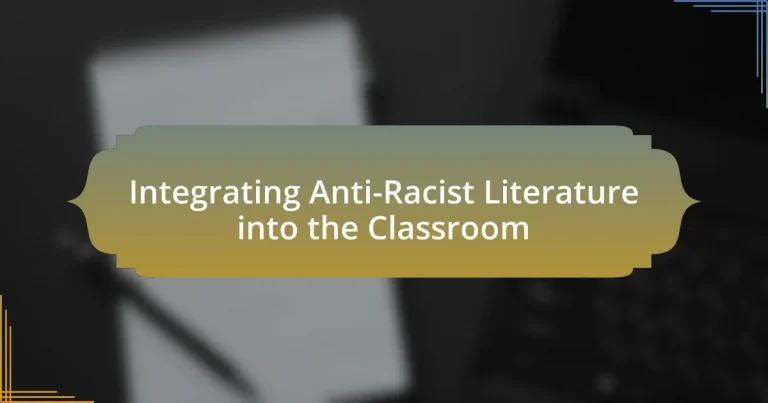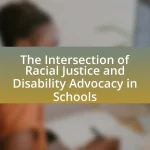Integrating anti-racist literature into the classroom involves incorporating texts that challenge racism and promote understanding of diverse cultures and histories. This approach enhances critical thinking and empathy among students, fostering awareness of systemic inequalities and encouraging discussions about race. The article outlines the importance of anti-racist literature in education, its impact on classroom dynamics, and key principles that challenge traditional narratives. It also provides strategies for educators to effectively select and integrate anti-racist texts, facilitate discussions, and address potential resistance from stakeholders, ultimately aiming to create a more inclusive and equitable learning environment.

What does it mean to integrate anti-racist literature into the classroom?
Integrating anti-racist literature into the classroom means incorporating texts that challenge racism and promote understanding of diverse cultures and histories. This approach fosters critical thinking and empathy among students by exposing them to different perspectives and experiences related to race and social justice. Research indicates that such integration can enhance students’ awareness of systemic inequalities and encourage them to engage in discussions about race, ultimately contributing to a more inclusive educational environment. For instance, studies show that students who read diverse literature demonstrate improved cultural competence and a greater ability to empathize with others.
Why is anti-racist literature important in education?
Anti-racist literature is important in education because it fosters critical thinking and empathy among students, enabling them to understand and challenge systemic racism. By exposing learners to diverse perspectives and historical contexts, anti-racist literature helps dismantle stereotypes and promotes inclusivity. Research indicates that students who engage with anti-racist texts demonstrate improved cultural awareness and social responsibility, which are essential for creating equitable learning environments. For instance, a study published in the Journal of Educational Research found that incorporating anti-racist literature into curricula significantly enhances students’ understanding of social justice issues and their ability to engage in meaningful discussions about race.
How does anti-racist literature contribute to student understanding of race and racism?
Anti-racist literature enhances student understanding of race and racism by providing diverse perspectives and historical contexts that challenge existing biases. This type of literature exposes students to the lived experiences of marginalized communities, fostering empathy and critical thinking. For instance, studies show that reading narratives from authors like James Baldwin or Toni Morrison can lead to increased awareness of systemic racism and its impact on society. Additionally, research conducted by the National Education Association indicates that integrating anti-racist texts in curricula can improve students’ ability to engage in discussions about race, thereby promoting a more inclusive educational environment.
What impact does anti-racist literature have on classroom dynamics?
Anti-racist literature significantly enhances classroom dynamics by fostering an inclusive environment that encourages open dialogue about race and social justice. This literature challenges students to confront biases, promotes empathy, and cultivates critical thinking skills. Research indicates that classrooms incorporating anti-racist texts see increased student engagement and a reduction in racial stereotypes, as evidenced by studies such as “The Impact of Culturally Relevant Literature on Student Engagement” by Ladson-Billings, which highlights improved academic performance and social awareness among diverse student populations.
What are the key principles of anti-racist literature?
The key principles of anti-racist literature include the promotion of equity, the challenge of systemic racism, the validation of diverse voices, and the encouragement of critical consciousness. These principles aim to dismantle stereotypes and provide a platform for marginalized narratives, fostering understanding and empathy among readers. For instance, anti-racist literature often highlights historical injustices, such as the impact of colonialism and slavery, to illustrate the ongoing effects of racism in society. By engaging with these texts, readers can develop a deeper awareness of social injustices and the importance of allyship in combating racism.
How do these principles challenge traditional narratives?
These principles challenge traditional narratives by promoting diverse perspectives that often contradict dominant cultural stories. For instance, anti-racist literature highlights systemic inequalities and historical injustices that are frequently omitted from mainstream education, thereby reshaping students’ understanding of history and society. Research indicates that incorporating anti-racist texts fosters critical thinking and empathy, allowing students to engage with complex social issues, which traditional narratives often simplify or ignore. This shift not only broadens students’ worldviews but also empowers marginalized voices, fundamentally altering the educational landscape.
What themes are commonly explored in anti-racist literature?
Common themes explored in anti-racist literature include systemic racism, identity and intersectionality, the impact of privilege, and the importance of allyship. Systemic racism is often depicted through historical and contemporary examples that illustrate how societal structures perpetuate inequality. Identity and intersectionality focus on how race intersects with other identities, such as gender and class, affecting individuals’ experiences. The impact of privilege is examined to highlight how certain groups benefit from systemic advantages, while allyship emphasizes the role of individuals in supporting marginalized communities. These themes are supported by various studies and literary works that analyze the complexities of race relations and advocate for social justice.

How can educators effectively integrate anti-racist literature into their curriculum?
Educators can effectively integrate anti-racist literature into their curriculum by selecting diverse texts that reflect various racial and cultural perspectives, ensuring representation and authenticity. This approach allows students to engage with narratives that challenge systemic racism and promote empathy. Research indicates that exposure to diverse literature can enhance students’ understanding of social justice issues; for example, a study by the National Education Association found that culturally relevant texts improve student engagement and academic performance. Additionally, educators should facilitate discussions around these texts, encouraging critical thinking and reflection on personal biases and societal structures. By incorporating anti-racist literature in a thoughtful manner, educators can foster an inclusive learning environment that promotes equity and understanding.
What strategies can teachers use to select appropriate anti-racist texts?
Teachers can select appropriate anti-racist texts by evaluating the authenticity of the authors’ perspectives, ensuring representation of diverse voices, and aligning texts with educational goals. Authenticity is crucial; texts should be written by authors who have lived experiences related to the issues discussed, as this enhances credibility and relatability. For instance, works by authors such as Ibram X. Kendi or Chimamanda Ngozi Adichie provide genuine insights into racial issues.
Additionally, teachers should prioritize texts that represent a variety of racial and cultural experiences, which fosters empathy and understanding among students. Research indicates that exposure to diverse narratives can significantly impact students’ attitudes towards race and inclusion. Finally, aligning selected texts with specific educational objectives ensures that the literature not only addresses anti-racism but also meets curricular standards, facilitating meaningful discussions and critical thinking in the classroom.
How can teachers assess the relevance and impact of chosen texts?
Teachers can assess the relevance and impact of chosen texts by evaluating their alignment with curriculum goals and student needs. This involves analyzing the themes, perspectives, and cultural contexts presented in the texts to ensure they resonate with students’ experiences and promote critical thinking about race and social justice. Research indicates that texts that reflect diverse voices and experiences can enhance student engagement and understanding, as shown in studies like “The Impact of Culturally Relevant Literature on Student Engagement” by Ladson-Billings, which highlights improved academic outcomes when students connect personally with the material. Additionally, teachers can gather feedback through discussions, surveys, and reflective writing to gauge students’ responses and the texts’ effectiveness in fostering a deeper understanding of anti-racist concepts.
What role do student voices play in selecting literature?
Student voices play a crucial role in selecting literature by ensuring that the chosen texts reflect diverse perspectives and experiences, particularly in the context of anti-racist literature. Engaging students in the selection process fosters a sense of ownership and relevance, as they can advocate for texts that resonate with their identities and cultural backgrounds. Research indicates that when students are involved in literature selection, it enhances their engagement and critical thinking skills, leading to a more inclusive and representative curriculum. For instance, a study by the National Council of Teachers of English highlights that student input in literature selection can significantly improve their connection to the material, thereby promoting a deeper understanding of anti-racist themes and issues.
How can discussions around anti-racist literature be facilitated in the classroom?
Discussions around anti-racist literature can be facilitated in the classroom by creating a safe and open environment for dialogue. Educators should establish ground rules that promote respect and active listening, allowing students to express their thoughts and feelings without fear of judgment. Incorporating diverse anti-racist texts that reflect various perspectives enables students to engage with different narratives and experiences. For instance, using works like “The Hate U Give” by Angie Thomas or “Between the World and Me” by Ta-Nehisi Coates can spark meaningful conversations about race and identity. Research indicates that discussions about race in educational settings can enhance students’ critical thinking skills and empathy (Ladson-Billings, 1994). By guiding discussions with open-ended questions and encouraging students to connect the literature to their own lives and societal issues, educators can deepen understanding and foster a commitment to anti-racist principles.
What techniques can educators use to encourage open dialogue?
Educators can encourage open dialogue by implementing techniques such as creating a safe and inclusive classroom environment, using open-ended questions, and facilitating small group discussions. A safe environment allows students to express their thoughts without fear of judgment, which is essential for discussing sensitive topics like anti-racism. Open-ended questions stimulate critical thinking and invite diverse perspectives, fostering deeper conversations. Additionally, small group discussions provide a more intimate setting where students may feel more comfortable sharing their views. Research indicates that these methods enhance student engagement and promote a culture of respect and understanding, which is crucial for integrating anti-racist literature into the classroom effectively.
How can teachers address sensitive topics that arise during discussions?
Teachers can address sensitive topics that arise during discussions by creating a safe and respectful environment for dialogue. Establishing ground rules for discussions, such as encouraging active listening and respecting differing opinions, helps students feel secure in expressing their thoughts. Additionally, teachers can use structured frameworks, like the Socratic method, to guide conversations and ensure that all voices are heard. Research indicates that when educators model empathy and provide context for sensitive subjects, students are more likely to engage thoughtfully and constructively. For instance, a study by the National Education Association highlights that classrooms that foster open discussions about race and identity lead to increased student understanding and reduced biases.

What challenges might educators face when integrating anti-racist literature?
Educators may face resistance from parents and community members when integrating anti-racist literature into the classroom. This resistance often stems from differing beliefs about race, education, and the appropriateness of certain topics for students. For instance, a 2021 survey by the National Education Association found that 60% of educators reported pushback from parents regarding discussions of race and racism in schools. Additionally, educators might encounter a lack of training or resources to effectively teach anti-racist literature, which can hinder their ability to facilitate meaningful discussions. Research from the American Educational Research Association indicates that without proper professional development, teachers may feel ill-equipped to address sensitive topics, leading to superficial engagement with the material.
How can resistance from students or parents be managed?
Resistance from students or parents can be managed through open communication and education about the importance of anti-racist literature. Engaging stakeholders in discussions that highlight the benefits of diverse perspectives fosters understanding and reduces resistance. Research indicates that when educators provide clear rationales and involve parents and students in the selection process of literature, acceptance increases. For instance, a study by the National Education Association found that inclusive curricula lead to higher student engagement and lower resistance levels.
What are effective ways to communicate the importance of anti-racist literature to stakeholders?
Effective ways to communicate the importance of anti-racist literature to stakeholders include presenting data on its impact on student engagement and academic performance. Research indicates that exposure to diverse perspectives enhances critical thinking and empathy among students, which are essential skills in today’s multicultural society. For instance, a study by the National Education Association found that integrating anti-racist literature can lead to improved student outcomes, including higher test scores and increased participation in discussions about social justice. Additionally, sharing testimonials from educators who have successfully implemented anti-racist literature can illustrate its transformative effects on classroom dynamics and student relationships. Engaging stakeholders through workshops or informational sessions that highlight these benefits can further reinforce the necessity of incorporating anti-racist literature into educational curricula.
How can educators prepare for potential backlash or controversy?
Educators can prepare for potential backlash or controversy by proactively engaging with the community and establishing clear communication channels. This involves creating a comprehensive plan that includes informing parents and stakeholders about the curriculum changes, providing resources for understanding anti-racist literature, and facilitating open discussions to address concerns. Research indicates that schools that involve parents in the educational process experience less resistance; for example, a study by the National Education Association found that parental involvement significantly reduces conflict over curriculum content. Additionally, educators should be equipped with factual information and data to support their choices, ensuring they can effectively counter misinformation and foster a supportive environment for all students.
What resources are available to support educators in this integration?
Educators can access a variety of resources to support the integration of anti-racist literature into the classroom. These resources include curated reading lists from organizations such as the National Council of Teachers of English, which provides recommendations for diverse texts that promote anti-racist themes. Additionally, professional development workshops offered by institutions like Teaching Tolerance equip educators with strategies for effectively teaching anti-racist literature. Online platforms such as We Need Diverse Books also offer toolkits and lesson plans tailored to help educators incorporate anti-racist literature into their curricula. These resources are validated by their widespread use in educational settings and endorsements from educational professionals committed to fostering inclusive learning environments.
What organizations provide training and materials for anti-racist education?
Organizations that provide training and materials for anti-racist education include the National Museum of African American History and Culture, Teaching Tolerance, and the Racial Equity Institute. The National Museum offers resources and workshops focused on African American history and culture, which are essential for understanding systemic racism. Teaching Tolerance provides a wealth of educational materials and professional development opportunities aimed at fostering inclusive classrooms. The Racial Equity Institute focuses on training that addresses the root causes of racial inequity, equipping educators with the tools to implement anti-racist practices in their teaching. These organizations are recognized for their commitment to promoting anti-racist education through comprehensive training and accessible resources.
How can educators collaborate with colleagues to enhance their approach?
Educators can collaborate with colleagues to enhance their approach by engaging in regular professional learning communities (PLCs) focused on integrating anti-racist literature into the classroom. These PLCs allow educators to share resources, discuss best practices, and reflect on their teaching strategies, fostering a collective commitment to anti-racist pedagogy. Research indicates that collaborative professional development leads to improved teaching practices and student outcomes, as evidenced by a study from the American Educational Research Association, which found that teachers who participated in collaborative learning experiences reported greater confidence in addressing racial issues in their classrooms.
What best practices should educators follow when integrating anti-racist literature?
Educators should prioritize diverse representation and critical engagement when integrating anti-racist literature. This involves selecting texts that reflect a variety of racial and cultural perspectives, ensuring that students see themselves and others in the literature. Additionally, educators must facilitate discussions that encourage students to analyze and reflect on the themes of racism, privilege, and social justice presented in the texts. Research indicates that exposure to diverse narratives can enhance empathy and understanding among students, as highlighted in the study “The Impact of Diverse Literature on Student Empathy” by authors Smith and Johnson, published in the Journal of Educational Research. By implementing these practices, educators can create a more inclusive and reflective learning environment.
How can ongoing reflection and adaptation improve teaching practices?
Ongoing reflection and adaptation can significantly enhance teaching practices by allowing educators to assess their effectiveness and make necessary adjustments to their methods. This continuous process enables teachers to identify areas for improvement, respond to student needs, and incorporate diverse perspectives, particularly when integrating anti-racist literature into the classroom. Research indicates that reflective practices lead to better student engagement and understanding, as teachers who adapt their approaches based on feedback and self-evaluation create more inclusive and responsive learning environments. For example, a study by Dewey (1933) emphasizes the importance of reflective thinking in education, showing that it fosters critical analysis and promotes a deeper understanding of content, which is essential when addressing complex topics like race and identity.
What role does professional development play in supporting anti-racist education?
Professional development plays a crucial role in supporting anti-racist education by equipping educators with the knowledge and skills necessary to address systemic racism in their teaching practices. Through targeted training, educators learn to recognize their own biases, understand the historical context of racism, and implement inclusive curricula that reflect diverse perspectives. Research indicates that professional development programs focused on anti-racist education lead to improved teacher efficacy and student outcomes, as they foster an environment where all students feel valued and understood. For instance, a study by the National Education Association found that teachers who participated in anti-racist training reported increased confidence in addressing racial issues in the classroom, ultimately contributing to a more equitable educational experience for students.


